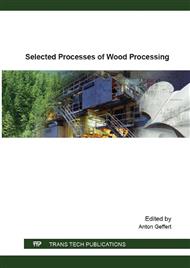[1]
L. Lesage-Meessen, M. Bou, J. C. Sigoillot, C. B. Faulds, A. Lomascolo, Essential oils and distilled straws of lavender and lavandin: a review of current use and potential application in white biotechnology, Appl Microbiol Biotechnol 99 (2015).
DOI: 10.1007/s00253-015-6511-7
Google Scholar
[2]
M. Jablonsky, M. Vernarecova, A. Haz, A. Skulcova, L. Dubinyova, A. Sladkova, I. Surina, Extraction of phenolic and lipophilic compounds from spruce (Picea abies) bark using accelerated solvent extraction by ethanol, Wood Research 60 (2015).
Google Scholar
[3]
C. Porto, D. Da Decorti, I. Kikic, Flavour compounds of Lavandula angustifolia L. to use in food manufacturing: Comparison of three different extraction methods, Food Chemistry 112 (2008) 1072-1078.
DOI: 10.1016/j.foodchem.2008.07.015
Google Scholar
[4]
S. Périno-Issartier, C. Ginies, G. Cravotto, F. Chemat, A comparison of essential oils obtained from lavandin via different extraction processes: Ultrasound, microwave, turbohydrodistillation, steam and hydrodistillation, Journal of Chromatography A. 1305 (2013).
DOI: 10.1016/j.chroma.2013.07.024
Google Scholar
[5]
A. Farhat, C. Ginies, M. Romdhane, F. Chemat, Eco-fiendly and cleaner process for isolation of essential oil using microwave energy, Experimental and theoretical study. Journal of Chromatography A. 1216 (2009) 5077-5085.
DOI: 10.1016/j.chroma.2009.04.084
Google Scholar
[6]
F. Chemat, M. E. Lucchesi, J. Smadja, L. Favretto, G. Colnaghi, F. Visinoni, Microwave accelerated steam distillation of essential oil from lavender: A rapid, clean and environmentally friendly approach, Analytica Chimica Acta 555 (2006) 157–160.
DOI: 10.1016/j.aca.2005.08.071
Google Scholar
[7]
H. Kamali, M. R. Jalilvand, N. Aminimoghadamfarouj, Pressurized fluid extraction of essential oil from Lavandula hybrida using a modified supercritical fluid extractor and a central composite design for optimization, Journal of Separation Science 35 (2012).
DOI: 10.1002/jssc.201200043
Google Scholar
[8]
L.T. Danh, N.D.A. Triet, L.T.N. Han, J. Zhao, R. Mammucari, N. Foster, Antioxidant activity, yield and chemical composition of lavender essential oil extracted by supercritical CO2, J. Supercrit. Fluids 70 (2012) 27–34.
DOI: 10.1016/j.supflu.2012.06.008
Google Scholar
[9]
A. Carrasco, V. Ortiz-Ruiz, R. Martinez-Gutierrez, V. Tomas, J. Tudela, Lavandula stoechas essential oil from Spain: Aromatic profile determined by gas chromatography–mass spectrometry, antioxidant and lipoxygenase inhibitory bioactivities, Industrial Crops and Products 73 (2015).
DOI: 10.1016/j.indcrop.2015.03.088
Google Scholar
[10]
M. Co, A. Fagerlund, L. Engman, K. Sunnerheim, P. J. R. Sjöberg, Ch. Turner, Extraction of antioxidants from spruce (Picea abies) bark using eco-friendly sovents, Phytochemical Analysis 23 (2011) 1-11.
DOI: 10.1002/pca.1316
Google Scholar
[11]
V.D. Zheljazkov, T. Astatkie, A.N. Hristov, Lavender and hyssop productivity oil content, and bioactivity as a function of harvest time and drying, Ind. Crop. Prod. 36 (2012) 222–228.
DOI: 10.1016/j.indcrop.2011.09.010
Google Scholar
[12]
V.D. Zheljazkov, Ch. L. Cantrell, T. Astatkie, E. Jeliazkova, Distillation time effect on lavender essential oil yield and composition, J. Oleo Sci 62 (2013) 195-199.
DOI: 10.5650/jos.62.195
Google Scholar
[13]
V. Nađalin, Ž. Lepojević, M. Ristić, J. Vladić, B. Nikolovski, D. Adamović, Investigation of cultivated lavender (Lavandula officinalis L. ) extraction and its extracts, Chemical Industry and Chemical Engineering Quarterly 20 (2014) 71-86.
DOI: 10.2298/ciceq120715103n
Google Scholar


